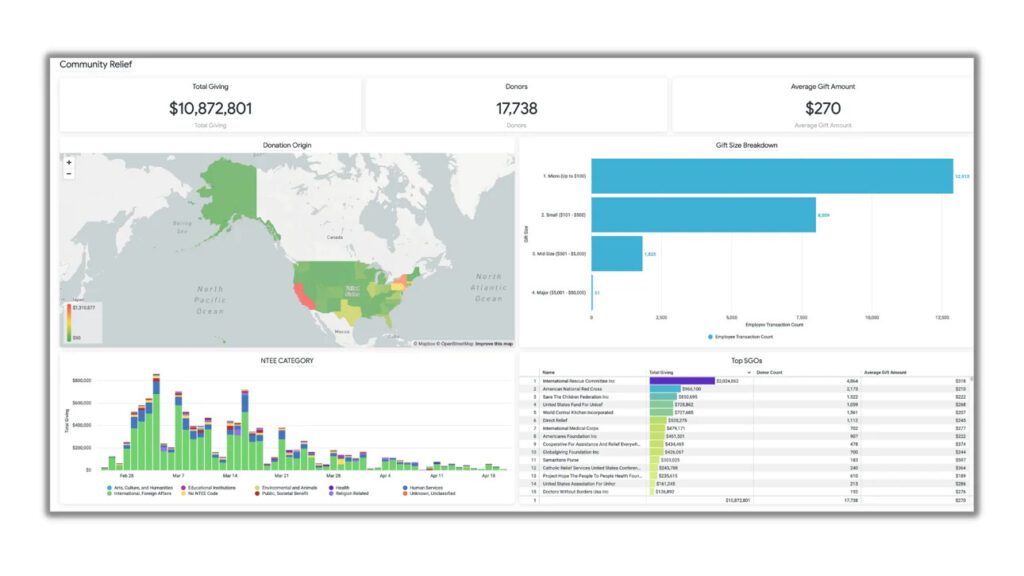Increase impact with a data-driven disaster response

When it comes to disaster relief, urgent needs often emerge overnight. Whether your business is facing a local crisis or you’re responding to an international conflict, time is of the essence. Your corporation needs to be equipped with tools to respond rapidly and effectively, even before the disaster hits. Preparedness is the key to a successful disaster relief and response program.
The best way to prepare for the next crisis is to integrate disaster relief into your overall corporate social responsibility (CSR) strategy. While you can’t always predict when or where the next crisis will hit, you can ensure that you have the programs and technology in place to drive maximum impact when the need arises.
Let’s get started by walking through some involvement opportunities your business can implement to motivate employees to support disaster victims.
Disaster relief ideas for your CSR program
When disaster strikes, you need to inspire rapid, passionate support from your workplace. To optimize your efforts, select initiatives that are easy to participate in and foster long-term support.
Here are a few suggestions:
- Personal giving: Consider offering flexible forms of giving to increase employee participation. Accepting credit card donations is a great way to make it convenient for employees to give.
- Matching gift programs: Employ a dollar-for-dollar matching gift program for employee donations. Through these programs, your business can double its impact and help more people affected by the crisis.
- Recurring giving or sustainer programs: Enable automatic, recurring giving for your employees. While disasters initially call our attention to immediate needs, their recovery efforts often require years of work after initial contributions have been exhausted.
- Partner nonprofit organizations: When a crisis happens, feature your nonprofit partners who need support, donations, or supplies on your CSR platform. This increased visibility is sure to encourage participation from your workforce.
- Employee Assistance Program (EAP): Keep in mind that an emerging crisis may affect your own employees. Establishing an Employee Assistance Program (EAP) allows your employees to request assistance in a time of need.
These simple ways to get involved will inspire support from your employees, helping them contribute to urgent causes and make a difference.
Optimize your program with data
You’ve come up with a disaster relief plan, implemented a program to support affected communities, and rallied your workforce behind the cause, so what are the next steps?
Start by tracking information about donors and their contributions. Regular data analysis throughout your campaign is key for measuring the program’s success and accurately tracking its impact. You’ll also be able to understand best practices and considerations for future campaigns.
To quickly build reports and analyze this data, invest in a tool that takes the hard work off your plate. Here’s how software can improve your company’s disaster response efforts:
- Reduce administrative burden: Shorten the amount of time spent on report configuration and manual manipulation with at-a-glance monitoring of data by status, region, focus area, dollar amount threshold, and more.
- Take control of compliance: Measure and track compliance and funding metrics (e.g., equitable funding) across all of your programs, including grants, employee giving, and volunteerism.
- Tell your impact story: Uncover insights and share them to provide deeper context for the support generated.
- Optimize and adapt your programs: Take a data-driven approach to strategically adapt and optimize your programs by combining traditional CSR data with web and support analytics.
- Enhance your data: Utilize census and demographic data to align matching gift and grant program spending with strategic initiatives, identify emerging trends, and understand deviations quickly for immediate action.
With CSR software, you’ll be able to quickly prepare a data dashboard to monitor donations in real time. Then, you can quickly and easily measure your disaster relief efforts and showcase their impact on affected communities.

Case study: CVS Health’s rapid response to the Ukraine crisis
On February 24, 2022, news of the Russian invasion of Ukraine broke. Russian President, Vladimir Putin, launched what he called “a special military operation” from multiple fronts aimed at demilitarizing Ukraine. As a result, civilians were forced to flee their homes and cross into neighboring countries for safety. The UN reports that more than eight million people left Ukraine to take refuge across Eastern Europe.
The invasion of Ukraine and the resulting refugee crisis left individuals and corporations alike grappling with how to help. In collaboration with Bonterra Corporate Social Responsibility, CVS Health quickly activated a disaster relief dashboard. This dashboard communicated philanthropic efforts to colleagues and offered a match of colleague donations from the CVS Health Foundation for emergency medical support, including:
- $100,000 to the American Red Cross to support emergency services for military families, evacuation support for U.S. Citizens, and humanitarian aid to the citizens of Ukraine and neighboring countries.
- $50,000 to Direct Relief to support medical care for refugees fleeing violence and disruption as well as the donation of pharmaceuticals, medical products, and mental health services to benefit public hospitals and clinics in Ukraine.
- Up to $50,000 in colleague-matching donations to support either the American Red Cross or Direct Relief for donations made through the end of March.
Within the first 24 hours of the campaign, CVS Health exceeded its colleague-matching goal of $50,000 and delivered on its promise to support affected communities with critical emergency services. By leveraging data dashboards, CVS Health got a closer look into campaign specifics to better understand colleague participation.
After launching their Ukraine response efforts through internal communications, there was a significant increase in the volume and frequency of colleagues leveraging the portal. Nearly 40% of participating colleagues were doing so for the first time, proving that quickly implementing a program can increase both engagement and participation rates.
We applaud CVS Health and its colleagues for their rapid response to the emerging conflict in Ukraine and their dedication to supporting affected communities. Thank you for your unwavering commitment to driving maximum social impact.
Making a larger impact with a data-driven response
Responding rapidly to a disaster or crisis may seem daunting, but it isn’t a task your company should have to tackle alone. By leveraging CSR technology, you’ll be able to rally your team, respond to urgent needs, and drive maximum social impact.
Ready to Get Started?
Work with Bonterra



